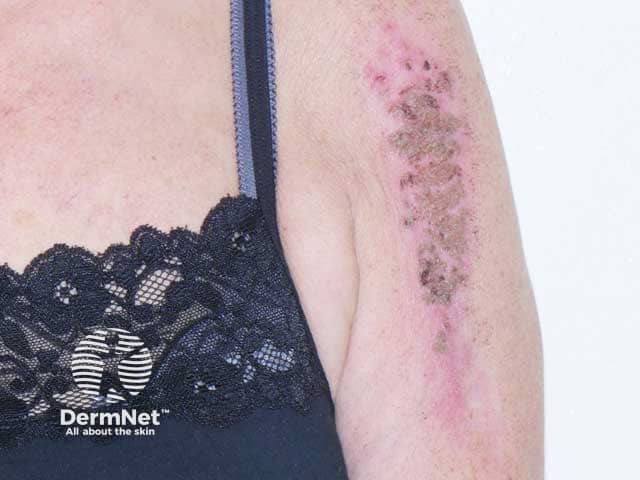Main menu
Common skin conditions

NEWS
Join DermNet PRO
Read more
Quick links
Aquagenic pruritus — extra information
Aquagenic pruritus
Authors: Dr Adam Dedat, Trainee General Practitioner and Dr Ian Coulson, Consultant Dermatologist, East Lancashire NHS Trust, UK. Copy edited by Gus Mitchell. April 2022
Introduction Demographics Causes Clinical features Complications Diagnosis Differential diagnoses Treatment Outcome
What is aquagenic pruritus?
Aquagenic pruritus is a severe prickling-like sensation/itch which is triggered by the presence of water at any temperature and of any type (such as rainwater, seawater, bath/tap water, and even sweat) on the skin. It is a variant of inducible pruritus.
Aquagenic pruritus can vary in severity between a mild nuisance to unbearably debilitating. It can be so severe as to result in a fear of bathing and water aversion. During the period of itching, the skin will appear normal; it is distinguishable from aquagenic urticaria, where itch is accompanied by wheals.
Who gets aquagenic pruritus?
- Mild water-induced itch is common; a large epidemiological study reported it in as many as 25% of young adult Nigerians.
- It is more common in women.
- Most patients present in their early 40s.
- It is more common in those who bathe in rainwater.
- It is generally much more severe in those with underlying associated haematological problems.
What causes aquagenic pruritus?
The cause of aquagenic pruritus is unknown, however, studies have shown that mast cell degranulation, localised release of acetylcholine, and increased cutaneous fibrinolytic activity all play a role.
Severe aquagenic pruritus with intense itching may be associated with and be a harbinger of haematological disease and malignancy, the best know associations being with:
- Polycythemia rubra vera (in over 45% of patients)
- Essential thrombocytosis
- Myelodysplasia
- Lymphoma
- Hypereosinophilic syndrome
- Hepatitis
- Antimalarial drug treatment.
Blood disorders may manifest several years after the onset of itch, and annual evaluation and haematology testing is recommended.
What are the clinical features of aquagenic pruritus?
Clinical characteristics include:
- Itching during or soon after bathing or showering at any temperature is the cardinal symptom; this can develop within seconds of exposure or up to 15 minutes after contact with water has ceased.
- The sensation of itch is symmetrical, with the thighs and upper arms most commonly affected.
- No visible changes in the skin are noted during the period of itching.
- Eventually the skin may show excoriations and lichenification after repeated scratching.

Excoriations on the upper arm due to severe aquagenic pruritus with polycythemia
What are the complications of aquagenic pruritus?
- Fear of bathing/water aversion
- Anxiety and depression
How is aquagenic pruritus diagnosed?
The diagnosis is made on the basis of the presence of characteristic symptoms following water exposure, with the absence of visible skin changes during the period of itch.
What is the differential diagnosis for aquagenic pruritus?
- Aquagenic urticaria and anaphylaxis: itch is accompanied by wheals.
- Cholinergic urticaria: only with warm or hot water exposure.
- Cold urticaria: will be induced only by cold water, as well as other cold stimuli.
What is the treatment for aquagenic pruritus?
General measures
- Itch may be less intense with cool baths and showers
- Use tap water rather than rainwater for bathing where it is possible
- Apply emollients
Specific measures
Treatment options include:
- Non-sedating antihistamines
- Addition of sodium bicarbonate to the bathwater
- Phototherapy for pruritus eg, UVB or PUVA
- Oral naltrexone
- Topical capsaicin
- Beta-alanine
- Ruxolitinib (in polycythemia-associated pruritus)
- Atenolol, propranolol
- Aprepitant
- Montelukast
- Omalizumab
What is the outcome of aquagenic pruritus?
Aquagenic pruritus can be an ongoing and a persistant problem, particularly when associated with blood disorders.
Bibliography
- Kligman AM, Greaves MW, Steinman H. Water-induced itching without cutaneous signs. Aquagenic pruritus. Arch Dermatol. 1986;122(2):183–6. Journal
- Sekar CS, Srinivas CR, Jacob S. Aquagenic pruritus: beneath water "lies". Indian J Dermatol. 2011;56(4):446–7. doi: 10.4103/0019-5154.84734. PubMed
- Salami TA, Samuel SO, Eze KC, Irekpita E, Oziegbe E, Momoh MO. Prevalence and characteristics of aquagenic pruritus in a young African population. BMC Dermatol. 2009;9:4. Published 2009 Apr 17. doi: 10.1186/1471-5945-9-4 PubMed Central
- Wang F, Zhao YK, Luo ZY, et al. Aquagenic cutaneous disorders. J Dtsch Dermatol Ges. 2017;15(6):602–8. doi: 10.1111/ddg.13234. Journal
